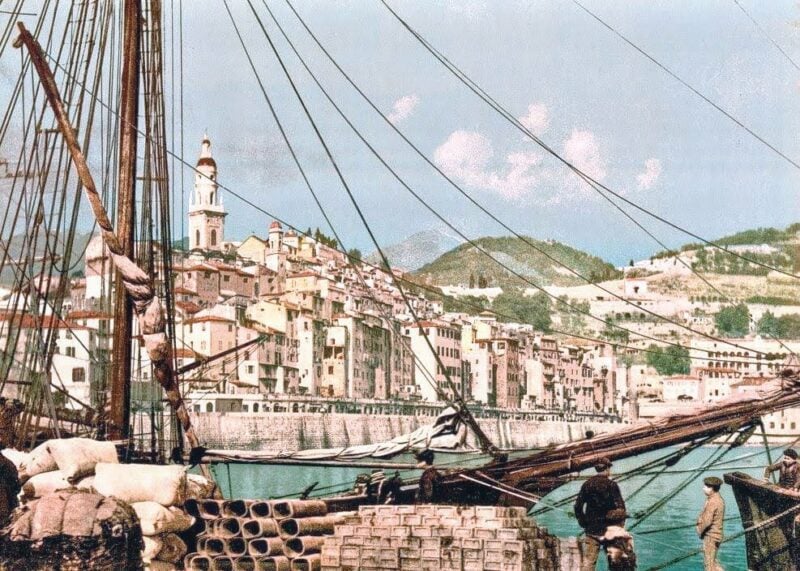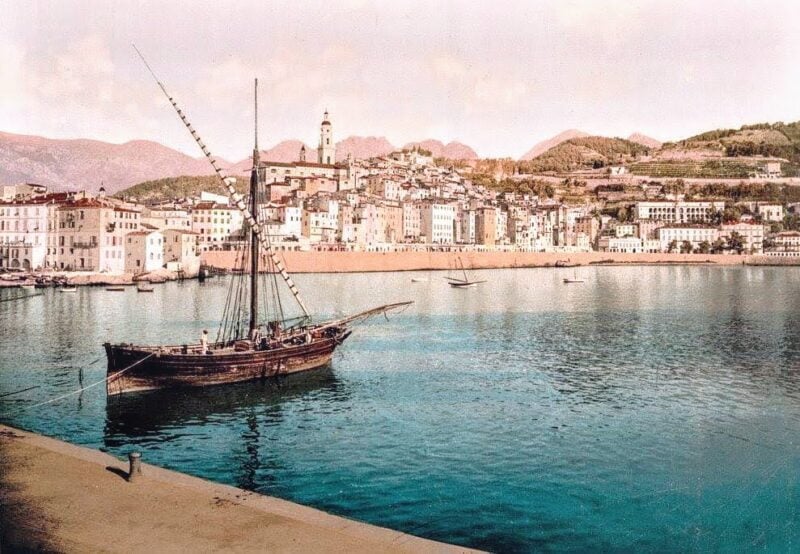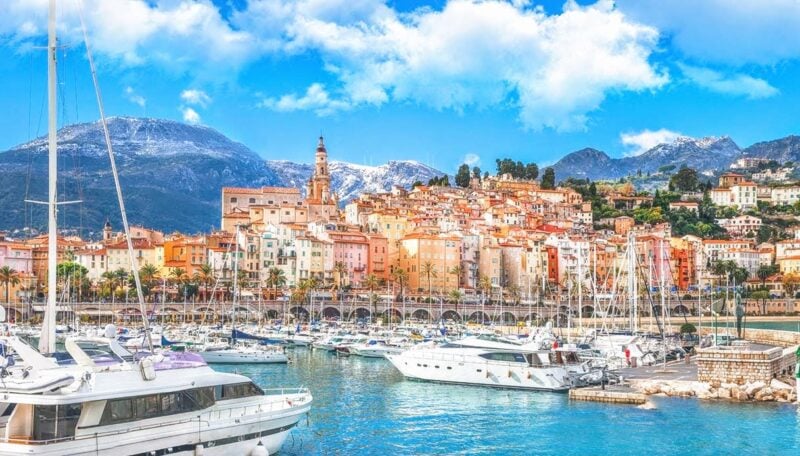Parancsikonok
A "francia riviéra" születése
The highly-Instagrammable seaside town of Menton Lehet, hogy kevésbé ismert, mint Riviéra szomszédai, de – Nice mellett – nagyban hozzájárult ahhoz, hogy a Francia Riviérát a világ talán legrégebbi téli üdülőhelyévé tegyék. Jean Cocteau painted his famous frescoes of love here, and English nobles planted exotic gardens around Italianate villas shaded by palm trees.
Tribes and Romans
A megszállás nyomai körülbelül 3000 évre nyúlnak vissza, de a 18. század végéig a később Côte d'Azur néven ismert terület egy távoli és elszegényedett vidék volt, főleg halászatról, olajfaligetekről és parfümökhöz használt virágokról ismert. A ma „liguroknak” nevezett törzsi emberek voltak a francia Riviéra első ismert lakói a történelmi időkben.
Nem sokat tudunk ezekről az őslakosokról, csak azt, hogy megerősített falvakat építettek, nevezetesen a modern Nice helyén. Néhány évszázaddal később a görögök túlzsúfoltak Phocaea moved, first into Massilia (Marseille), then outwards to Hyères and Nice, ahogyan azt szokták tenni mindenhol, ahol volt esély az iparra vagy a kereskedelemre.
The Greeks brought the vine (thoughtfully informing the earlier inhabitants what could be extracted from the wild stock indigenous to the area) as well as olives and other products of their advanced civilization. The Celts, who were at the same time putting down roots as far south as the Riviera, preferred the wilder hill country up from the coast — and to raid rather than trade.
The inhabitants of the land along this coastal strip had been accustomed to operating independently of “central” control. The Roman’s forced occupation –as commemorated by the trophy in La Turbie– fontos kivétel volt, de már akkor is csekély volt a megszállók száma, és sajátos feladatuk volt, a római bekötő- és kereskedelmi utak védelme, nem törődve a helyi lakosokkal.
A rómaiak visszavonulása után és a 18. század előtt a lakott földterületek apró részei voltak a sziklás, bozótos domboldalak és mocsaras folyótorkolatok széles sávjaihoz képest. A közösségek elszigetelődtek. A szúnyogok mindenkit megőrjítettek, a közlekedés veszélyes és lassú volt (kevés változott).
Above all, it was a dull place, poor and uncultured, dilapidated and neglected by the outside world. It was waiting to be “rescued”. Divided between French and “Italian” spheres of influence, it was not a coherent society even within its contentious borders. Then came the British to transform the area and create the “French Riviera” as we know it…
How the British Transformed the French Riviera
A 18. században az angol arisztokrácia körében kialakult az utazási kedv, különösen a francia Riviérán télen. Az Édenkertnek tekintett Dél-Franciaország természetes „útvonal” volt Olaszországhoz és kultúrájához, amely divatos hely volt az elit megtapasztalására.

Az angol felsőbb osztályok szezonális vándorlását más európai elit gyorsan lemásolta, enyhe telet keresve. A 19. század elején megjelent az egészségügyi érv – az emberek gyógykezelésként jártak ezekre a téli üdülőhelyekre.
The 18th century created the winter resort, and the 19th century sealed it.
The first British traveller to describe the area’s health benefits was the novelist Tobias Smollett, aki 1763-ban látogatott el Nice-ba, amikor még olasz város volt Szardíniai Királyság. Felhívta a brit arisztokrácia figyelmét Nice és meleg téli éghajlatára.Travels through France and Italy (különösen Nice)', 1766-ban íródott. Ez egy nagyon mulatságos, levél alakú utazási napló, amelyben beleszeretett Nice-be, előre látta Cannes (akkor egy kis falu) gyógyüdülő érdemeit. , és elképzelte a lehetőségeket a Corniche roads. Soon after it was published, sickly Brits started traveling to the French Riviera, thereby establishing it as the first winter resort area in the world.
Almost immediately, Scottish doctor John Brown picked up on this idea and became famous for prescribing what he called ‘climato-therapy’: a change in climate, to cure a variety of diseases. In 1780, he published his ‘Elements of Medicine‘, which for a time was an influential text. It set out his theories, often called the ‘Brunonian system of medicine’, which essentially understood all diseases as a matter of over or under-stimulation. The controversial and simplistic so-called ‘Brunonian theory' azt diktálta, hogy minden betegség két kategóriába sorolható: az inger hiánya és a túl sok inger által okozott betegségek. Ő és kortársai a mediterrán éghajlatot a tonizáló és nyugtató hatások széles választékának tekintették.

Keeping the momentum going, British doctor John Bunnell Davis wrote his 1807 book, ‘Nice ókori és újkori története‘. It became yet another voice which advocated for the French Riviera’s curative effect on disease. He wrote, “Who can for a moment doubt but that health is more likely to return when the path to its acquisition is strewn with flowers; when the painful burden that overwhelms the soul is alleviated by agreeable occupations, and when anxiety is exchanged for patience and resignation?”
Ez az elmélet nagyjából egy évszázadon át, egészen az 1800-as évek végéig uralta az európai orvosi gondolkodást, és az egész Földközi-tenger partja mintegy téli gyógyüdülőhelyté vált mindenféle betegségben (különösen a tuberkulózisban, amely Angliában minden hatodik halálát okozta). Miután Napóleont 1815-ben legyőzték, és a béke uralkodott a kontinensen, különösen a britek kezdtek özönleni Nice-ra, főleg az egészségük érdekében, és mindig télen.
François-Joseph-Victor Broussais, a famous French physician, became very popular in the beginning of the 1820s; his medicinal theory was based on the Brunonian theory. French historian Paul Gonnet noted that doctors sent “to our shores a colony of pale and listless English women and listless sons of nobility near death”.

The French Riviera’s popularity further exploded when British doctor James Henry Bennet started promoting Menton’s climate as a health cure-all. Bennet had studied medicine in Paris, and after working as a doctor for 25 years, contracted what he self-diagnosed as tuberculosis (ez azelőtt volt, hogy tudták volna, hogy az ok a baktérium). 1859-ben azt állította, hogy Mentonba ment, hogy „…egy csendes sarokban haljon meg, mint egy sebesült erdőlakó” (de valószínűbb, hogy ismerte a brunóniai elméletet, és meggyógyult). Ehelyett azonban egészségi állapota jelentősen megjavult, és a következő évben Olaszországba látogatott, de megállapította, hogy „a klasszikus vidék nagyvárosainak higiénikus állapota semmissé teszi a korábban megszerzett jót”. Nem nyűgözte le Olaszország, visszatért Mentonba, és orvosi gyakorlatba kezdett.
When he was completely healed he returned to England to let his patients know about Menton. Word spread fast, as notable patients of Bennet’s included Robert Louis Stevenson és Viktória királynő. Ettől kezdve minden telet Mentonban töltött.
His 1861 book ‘Winter and Spring on the Shores of the Mediterranean‘ quickly boosted the popularity of Menton (then called ‘Mentone’) as a destination. Bennet felt that the hot and dry climate of the French Riviera as well as a proper diet cured tuberculosis sufferers. It was later translated into other languages and published in other countries, bringing everyone from Germans to Americans to Menton. Other doctors soon joined in the chorus.
Míg Lord Brougham had recently put Cannes on the map A londoni felső földkéreg társadalmának gondosan kiválasztott tagjai számára Bennet könyve széles körben elterjedt, és az idegenforgalom elsöprő beáramlását hozta létre. Sok arisztokrata, többnyire különféle egészségügyi problémákkal küzdve özönlött a Francia Riviérára a gyógyulás reményében. Kétségtelen, hogy egynél több „fogyasztási” áldozatnak nem tuberkulózisa, hanem asztmája volt, és a hideg, nyirkos és nagyon szmogos brit városok elmenekülése lett volna a szükséges „gyógyszer”.

In 1882, Viktória királynő megfogadta Bennet tanácsát, és eljött egy hosszabb vakációra, megnyitva a zsilipeket a királyiak és a nagyközönség előtt. Nyolcszor látogatott el ezután, és elmondta barátainak, mennyire szereti a környéket.
At the Queen’s suggestion, Winston Churchill chose to paint its’ landscapes, and many famous 19th century travel writers (such as Robert Louis Stevenson, Somerset Maugham, Scott Fitzgerald, Ernest Hemingway, H.G. Wells, Edith Wharton, Louisa May Alcott and Aldous Huxley) started writing about it.
Railways were built, grand villas replaced stone farmhouses, and ornate carriages carrying dukes and princes started showing up along high coast roads above the sparkling sea. Soon after, the French Riviera became famous in the USA as a high-end and glamorous vacation spot for celebrities and jet-setters.
Throughout the 20th century, Americans further transformed the French Riviera, with many of the most famous American authors and movie stars spending time or moving here. Superstar Grace Kelly married the Prince of Monaco, Rita Hayworth met and married a prince here, Sean Connery villát vett itt: Nice and filmed scenes of ‘Never Say Never’ in the old town of Menton, and Americans with wealth or fame vacationed here.
Without the influence of wealthy Brits and Americans, the French Riviera would not be what it is today.
The French finally discovered the area as a vacation spot well after the English-speakers, and eventually started building smaller vacation homes and apartment blocks up and down the coast. Now, the French Riviera is a crowded mix of tourists, English-speaking expats, and French people.